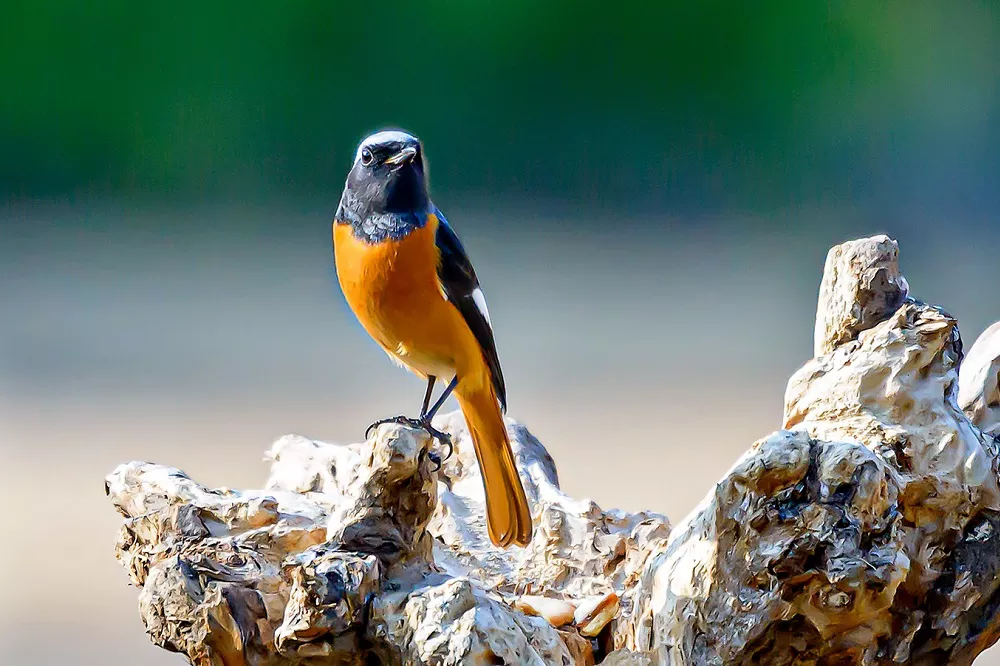The Daurian Redstart (Phoenicurus auroreus) is a small passerine bird that belongs to the family Muscicapidae. It is widely distributed across East Asia, particularly in countries such as China, Japan, and Korea. Known for its vibrant plumage and distinctive features, the Daurian Redstart is a visually striking species that captures the attention of bird enthusiasts and researchers alike.
Size and Shape
Measuring about 13-14 centimeters in length, the Daurian Redstart is relatively small in size. It has a compact body with a short tail and wings. The male and female birds exhibit sexual dimorphism, with males being slightly larger than females. Despite their small size, Daurian Redstarts are known for their agility and swift flight.
Plumage
The plumage of the Daurian Redstart differs significantly between males and females. Male birds display vibrant and eye-catching colors, while females have more subdued plumage. Here’s a closer look at the plumage characteristics of both sexes:
Male: The breeding plumage of male Daurian Redstarts is characterized by a combination of black, gray, and orange-colored feathers. Their head, back, and upperparts are predominantly black, creating a striking contrast against their bright orange-red breast and vent area. The wings and tail feathers are dark brown or black, with white patches on the wing coverts. During non-breeding periods, the male’s plumage becomes less vibrant, resembling that of females but retaining some traces of orange-red on the breast and flanks.
Female: Female Daurian Redstarts have a more subtle appearance compared to their male counterparts. They have olive-brown or greyish-brown upperparts, which provide excellent camouflage against their natural habitats. The underparts of females are paler, with a yellowish or buff-colored breast and belly. They lack the vibrant orange-red colors that distinguish the males.
Distinctive Features
In addition to their striking plumage, Daurian Redstarts possess several distinctive features that make them easily recognizable:
1. Red Tail: Both male and female Daurian Redstarts have a reddish-orange tail, which stands out against the rest of their plumage. This feature is especially prominent when the birds are in flight, adding a splash of color to their appearance.
2. White Wing Patches: When the wings are spread, noticeable white patches become visible on the wing coverts of both males and females. These patches provide a stark contrast against the dark-colored feathers and contribute to the bird’s overall aesthetic appeal.
3. Black Mask: Male Daurian Redstarts have a black mask-like marking around their eyes, extending from the bill to the ears. This mask adds a touch of mystery to their appearance and helps distinguish them from other similar-looking species.
Juvenile Plumage
The plumage of juvenile Daurian Redstarts differs from that of adult birds. Young redstarts have a more uniform brownish-gray coloration with less distinct patterns. As they mature, they gradually acquire the adult plumage characteristics over time.
Habitat and Range
Daurian Redstarts inhabit a diverse range of habitats, including forests, woodlands, shrublands, and mountainous regions. They are commonly found near streams, rivers, and other water sources. Their preferred habitats offer a mixture of open spaces for feeding and perching as well as dense vegetation for nesting and shelter.
The species has a wide distribution across East Asia. They breed in various parts of China, Mongolia, Japan, Korea, and Russia. During the winter months, Daurian Redstarts undertake migratory journeys, with some individuals traveling as far south as Southeast Asia and the Indian subcontinent.
Behavior and Diet
Daurian Redstarts are known for their active and agile behavior. They are highly territorial during the breeding season and defend their chosen nesting sites vigorously. The males often perform aerial displays, hovering in mid-air while singing melodious songs to attract females.
Their diet primarily consists of insects, spiders, and other small invertebrates. Daurian Redstarts forage by hopping on the ground or flying out from perches to catch prey in mid-air. They occasionally supplement their diet with berries and fruits when available.
Conservation Status
The Daurian Redstart is currently classified as a species of least concern by the International Union for Conservation of Nature (IUCN). Although this bird faces certain threats, such as habitat loss due to deforestation and urbanization, its population remains stable across most parts of its range. Conservation efforts focused on preserving suitable habitats and raising awareness about the importance of biodiversity can contribute to the continued survival of this captivating species.
Conclusion
The Daurian Redstart’s enchanting beauty is a testament to the wonders of the natural world. The vibrancy and contrast of the male’s reddish-orange plumage, complemented by the elegance of the black and white tail, create a visual symphony that captivates observers. The subtle charm and adaptability of the female’s subdued colors further emphasize the species’ ability to blend seamlessly into its environment.
With their distinctive features, agile flight, and graceful behavior, Daurian Redstarts leave an indelible impression on bird enthusiasts and nature lovers alike. They serve as a reminder of the diverse and captivating avian life that graces our planet. Appreciating the visual allure and understanding the unique traits of the Daurian Redstart enriches our connection to the natural world and reminds us of the remarkable beauty that surrounds us.


 Facebook
Facebook  Instagram
Instagram  Youtube
Youtube 